PRIVATE WILBERT DACK
[Submitted by B, November 2014]
This is a postcard I recently purchased. No postmark.
Private Dack, son of James King Dack and Effie Hewitt, was born in Leeds, Ontario.
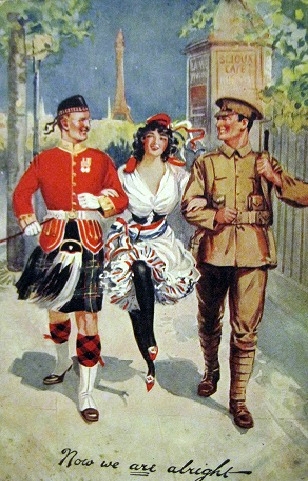 Dear Florence- I hope you are enjoying your self this winter. I hope I will be home soon now as the war is over and I like to get back to see you and all the rest. I suppose you like to know what we are doing well not much but still doing a little. Our board is a lot better now. I don’t think I will be home until June or July but I like to be home by the 24 of May so I could spend the day with you. I will close for this time. Dear Florence- I hope you are enjoying your self this winter. I hope I will be home soon now as the war is over and I like to get back to see you and all the rest. I suppose you like to know what we are doing well not much but still doing a little. Our board is a lot better now. I don’t think I will be home until June or July but I like to be home by the 24 of May so I could spend the day with you. I will close for this time.
Pte. Wilbert Dack
# 309439
6th Canadian Reserve Battalion
Seaford Camp
Sussex England
xxxxxx |
[Submitted by B, November 2014]
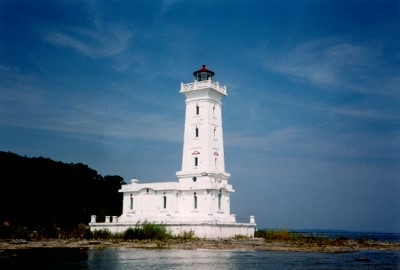
On my bucket list is a night sleeping in a lighthouse. The late Mr. Anonymous and I had spent many happy hours visiting these marvelous old structures, many now gone or in disrepair, and one of the finest we explored from a distance was Point Abino. One can not spend the night there, but tours are now arranged to see the lighthouse up close. I hope to take advantage of this opportunity next summer.
The lighthouse is 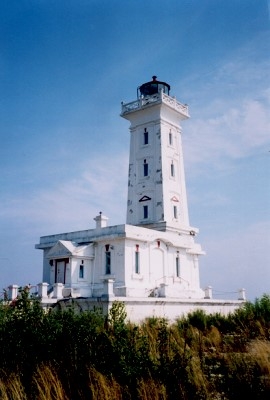 situated on a small plot of land owned by the Town of Fort Erie, but as Americans in gated communities own the surrounding landscape, it was impossible at the time to access this piece of history. We simply had to get closer, so we put the canoe in the water and paddled our way to Utopia. As long as we didn’t venture onto private land and stayed on Lake Erie, we were fine. Mr. Anonymous, bless his heart, could paddle at the speed of light if need be, but without a doubt it was a calm, pleasant journey. I have always thought of my canoe as a miniature yacht, so despite a few furrowed brows from the seamen on larger watercraft, we fit right in.
situated on a small plot of land owned by the Town of Fort Erie, but as Americans in gated communities own the surrounding landscape, it was impossible at the time to access this piece of history. We simply had to get closer, so we put the canoe in the water and paddled our way to Utopia. As long as we didn’t venture onto private land and stayed on Lake Erie, we were fine. Mr. Anonymous, bless his heart, could paddle at the speed of light if need be, but without a doubt it was a calm, pleasant journey. I have always thought of my canoe as a miniature yacht, so despite a few furrowed brows from the seamen on larger watercraft, we fit right in.
Some of these aged lighthouses have been recorded as being haunted, such as Gibraltar Point on Toronto Island, the oldest existing lighthouse on the Great Lakes. I have visited it several times, and thoroughly enjoy the mysterious story surrounding the famed lighthouse keeper, John Paul Radelmüller, who was murdered in 1815. Many a wondrous tale could all light keepers report of their lonely existence and challenging labor. They are truly to be respected.
[Submitted by B, October 2014]
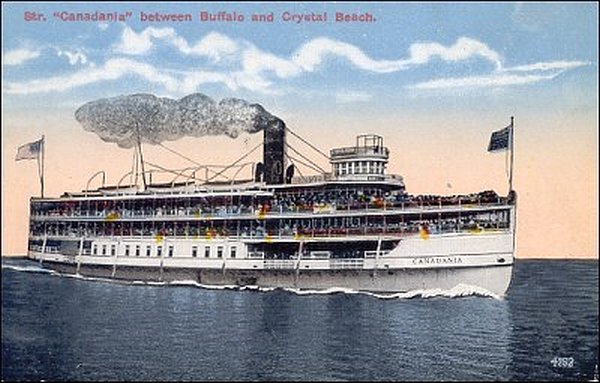
I love travelling by water with its mesmerizing pull and constant changing voice. I have had the chance to spend time on many of Ontario’s ferries and always find the ride exhilarating. My late father occasionally spoke about his journeys from Crystal Beach to Buffalo on The Canadiana. It was during his youthful years when he would travel to the big city to admire the sights and attend the live shows. Beer was cheap and the ticket return was 50 cents. I have no recollection of his mentioning having danced the night away to the music of the big bands on board the ferry or promenading on the hardwood deck, but being extremely reserved, he most likely just quietly enjoyed the short trip across the lake. Living with his family on a farm in Stevensville, this was probably a great Saturday night adventure for a young man. When the Canadiana was sent to Ramey’s Bend for dismantling, we took the opportunity to say good-bye.
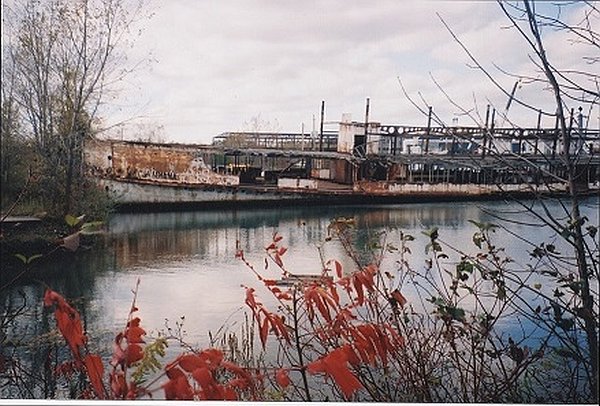
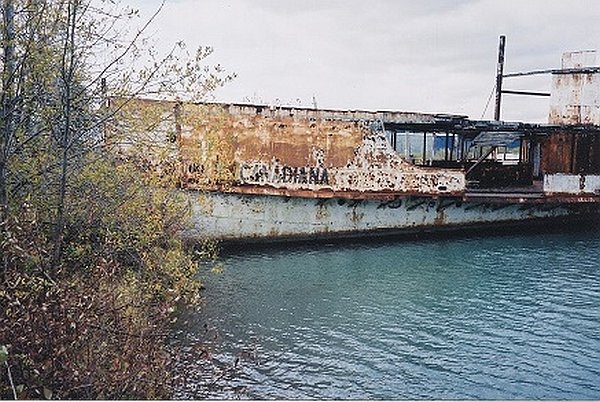
The Canadiana, launched in 1910, carried commuters who worked in Buffalo and patrons of the amusement park, Crystal Beach, Ontario across the Niagara River. Towed to Ramey’s Bend in Port Colborne, the ferry met its fate at the end of April 2004 when it was cut up for scrap due to a lack of funds for its restoration.
For anyone wanting to investigate the Fort Erie Greater area more fully, plan to visit the Fort Erie Museum at www.museum.forterie.ca
They have a great seating area, hundreds of archival files and a wonderful staff to assist you in answering any questions you might have.
[Submitted by: B]
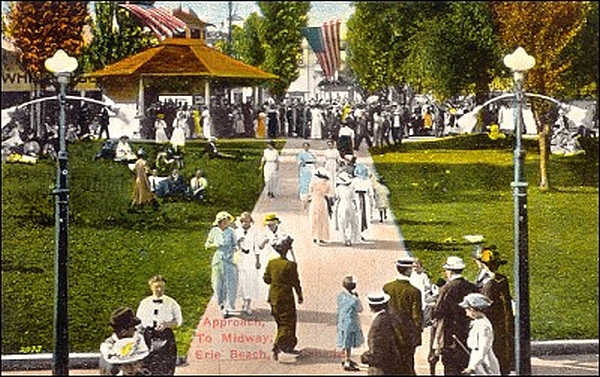
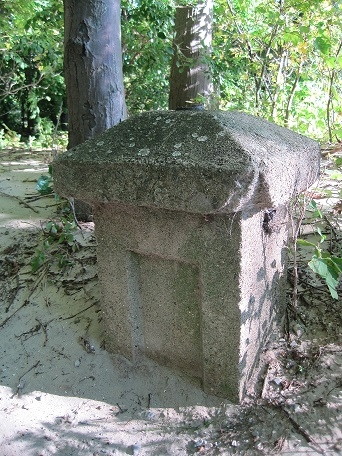 One of my favourite outings is walking the boardwalk on the Friendship Trail through the old Erie Beach Amusement Park. Running parallel to the north shore of Lake Erie, it is an historical treasure. In the late1800s and early 1900s, amusement parks usually located near a river, lake or other large body of water, became a prime source of entertainment for the public. They provided endless hours of diversion. Locales were chosen by the availability of mass transit and limited for the most part to two mediums: steamers and trains. Highways were virtually non-existent and motorized vehicles still a novelty.
One of my favourite outings is walking the boardwalk on the Friendship Trail through the old Erie Beach Amusement Park. Running parallel to the north shore of Lake Erie, it is an historical treasure. In the late1800s and early 1900s, amusement parks usually located near a river, lake or other large body of water, became a prime source of entertainment for the public. They provided endless hours of diversion. Locales were chosen by the availability of mass transit and limited for the most part to two mediums: steamers and trains. Highways were virtually non-existent and motorized vehicles still a novelty.
Most of the early amusement parks are gone now, victims of changing demographics, new modes of transportation and competition from the Internet, television and movies. Names such as Crystal Beach, Bob Lo, Lakeside Park, Grimsby Beach and Hanlans Point are mere memories; only a handful such as Cedar Point, Sandusky and the Canadian National Exhibition remain: islands of candy floss and roller coasters echoing with the shouts and laughter of children and adults alike. Today, like the bones of some prehistoric animal, the remnants of old buildings, broken piers, walkways and the outline of the once grand swimming pool are all that remain, but standing at one end of the boardwalk, one can almost envision the gaily dressed women, parasols in hand, escorted by men in their straw hats and suits walking arm in arm to and from the steamer. The entire area, once a magnificent playground, is now a rustic park with trails winding through the ruins and suburbia encroaching on its borders. Let us hope that a sense of history prevails and these majestic ruins are preserved just as they are.
[--All photographs are copyright Joe Barkovich 2014]
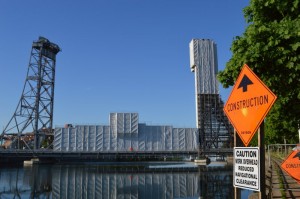 Main Street Bridge Under Renovation 2014
|
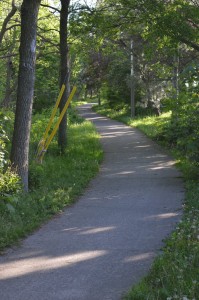 Pathway Along The Old Canal, Looking North |
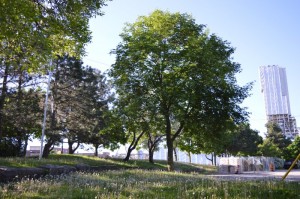 Along the Old Canal Looking in Direction of the Main Street Bridge |
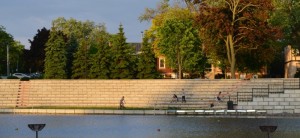 Canal-side Amphitheatre |
 Demolition in Progress |
[RELATED LINK: Reporter - Joe Barkovich]
{Compiled by “S”}
The journey of the printing press across Canada. by Louis Blake Duff. 1937.
The romance of our place—names; a series of eight radio addresses..February 20 to April 10, 1934, station CKTB, St Catharines; by Louis Blake Duff, 1934.
Names are pegs to hang history on. by Louis Blake Duff, 1926.
Muddiman, the first editor. by Louis Blake Duff, 1925.
Address to weekly newspaper editors on May 27, 1944 at Niagara Falls, Ontario by Louis Blake Duff, 1944.
John Brown at the battle of the Plains of Abraham. by Louis Blake Duff, 1927.
The county kerchief by Louis Blake Duff, 1949.
A study in vanity by Louis Blake Duff, 1952.
Samuel Chandler of St. Johns by Louis Blake Duff, 1938.
Amazing story of the Winghamite secretary of Louis Riel. by Louis Blake Duff, 1955.
Crowland by Louis Blake Duff, 1928.
The beginnings of the newspaper in Canada by Louis Blake Duff, 1929
The immortal memory; an address before the Burns literary society of Toronto, January 25, 1944 by Louis Blake Duff, 1945.
Papers and Records, Welland County Historical Society, 5v, 1924.
Address by Louis Blake Duff given at a dinner by Stephen Leacock memorial association on the occasion of the unveiling of a bronze bust of Stephen Leacock by Elizabeth Wyn Wood, Orillia public library, Friday, 14th September, 1951.
Sam Johnston: smuggler, soldier and bearer of news. By Louis Blake Duff, 1926.
Burnaby by Louis Blake Duff, 1926.
Huron Road centennial by Louis Blake Duff,1928.
Jane Susan Duff—her book by Louis Blake Duff, 1940.
Burnaby by Louis Blake Duff, 1927.
A shepherd’s crook on the hills of St. Johns by Louis Blake Duff, 1952.
Nihon no koika gyorui= Cyprinid Fishes of History of Cyprinid of Japan by Louis Blake Duff.
Hundredth Anniversary of Trinity Church, Chippawa by Louis Blake Duff, 1921.
Trinity Church, Chippawa 1820-1920: Hundredth Anniversary by Louis Blake Duff, 1920.
Good will in Fields of Peace by Louis Blake Duff, 1941.
From a Doss-house to Parnassus by Louis Blake Duff, 1934.
The Earliest Canadian Travel Books by Louis Blake Duff, 1935.
Louis Blake Duff Papers, 1932.
Correspondence with Prof. Norman J. Endicott, by J. Kemp Waldie, Norman Endicott, Louis Blake Duff, 1942.
As it Appears to Us by Louis Blake Duff, Lee F. Heacock, Buffalo Area Chamber of Commerce, 1928.
Louis Blake Duff: A Neglected Icon in Canada’s Print History by Peter Saracino.
Devil’s Artisan #54, Spring/Summer 2004
We think it’s so: being an assortment of editorial opinions from the Times-Review of Fort Erie, 1941.
The Vanished Village of the Shorthills by Louis Blake Duff, Canadian Historical Review, v13n3, 251-257., 1932.
Local Historical Societies: The problems and Opportunities of Canadian Historical Societies by Louis Blake Duff. Canadian Historical Review v13n3, 251-257, 1932.
The lost Lincoln order by William J. McCulloch, Louis Blake Duff, Nathaniel Benson, Lincoln Fellowship of Hamilton Ont. Meeting, 1957.
Robert Browning by Edward Dowden, Louis Blake Duff, 1904.
Louis Blake Duff Papers, 1932-1953.
Tourist and historical supplement by Louis Blake Duff, 1937.
The Printer of the Jesuit “Relations” by Louis Blake Duff, article Colophon v2 no2, 33-41, 1936
Welland Ship Canal by Louis Blake Duff, 1930.
The Greatest Englishman of history: an address by Arthur Meighen, Louis Blake Duff, 1954.
Die fruhesten canadischen reisebeschreibungen. By Louis Blake Duff, Herberth E. Herlitschka 1935
Thje buk ov samz: in Mikmak by Silas Tertius Rand; Louis Blake Duff.
College life: Dr. R. Tait McKenzie, OAC Review, v40, no 7, Mar 1928, p.245-246. By Louis Blake Duff; Tait McKenzie.
Literary section: H.M.S Pinafore/ Tom Bell, OAC Review, v45, no.5 Feb 1932, p. 292-294. By Louis Blake Duff and others..
By Joe Barkovich
Just call me a “hometown boy”. Having lived here, Welland that is, for six decades and then some, I think I’ve earned the appellation.
I love this place. I know it like the palm of my hand. I discovered alleys and avenues, side streets and main drags when I was kid, driving my Huffy balloon tire bike around town from sunrise to sundown, especially in the summer holidays.
We lived in a tight-knit part of town back then, the early -50s to the mid-60s.It was the King Street neighbourhood, especially the part from Fourth Street to Sixth Street, although some might include Seventh Street even though it was on the other side of the railway tracks.
We had three neighbourhood mom and pop grocery stores in the space of two blocks: Spitali and Sons (later Silenzi’s), John Husnik’s store and Ideal Meat Market. Old man Gronski’s shoe store was between Husnik’s and Ideal Meat Market, which was a neighbour to Mr. Hannah’s Rexall Drug Store. Then there was Doc Singer’s office and Morrison’s department store at the corner of Sixth.
I can’t forget Pete Santone’s barber shop – where you could sit for hours listening to stories about Welland and Crowland Township politics, as well as other news, rumours and gossip. But the gem of the neighbourhood, at least in my books, was Joe Miller’s sporting goods and variety store. We bought our penny candy there, as well as sunflower seeds – everybody, more or less, chewed sunflower seeds back then and our pop – do you remember a brand named Evangeline, and of course Orange Crush, which came in brown, “ribbed” bottles as I used to call them.
This was a blue-collar part of Welland, big time. Folks worked at places like Plymouth Cordage, a rope maker, Electro Metals (later Union Carbide), Wabasso, better known as the “cotton mill” and of course the Page Hersey plant, a pipe maker, to name a few. Other big employers were Atlas Steels and John Deere. All are gone now.
I said it was a tight-knit neighbourhood because it was. It was ethnic (largely Croatian, Polish and Italian), francophone families and overwhelmingly Roman Catholic. Everyone knew everyone else. On Halloween nights, when it was chilly or downright cold, you could expect to be invited into one baba or another’s kitchen for a bowl of homemade cabbage soup – just to warm you up! What a touch of class that was.
Way back then, we lived with my maternal grandparents but made the move to the west side of Welland when I was in my mid to late teens. I never wanted to leave Welland, and so I didn’t. I had two jobs in my lifetime – one in the financial services industry and the other – the love of my life – at the local newspaper. Started there in the spring of 1969 and left in the fall of 2012.
I witnessed many big events in Welland’s life story over those years – like in December, 1972 when a crowd estimated at about 25,000 jammed the city’s downtown to watch the ceremonial closing of the Main Street bridge; because a bypass section of canal was built, lakers and salties no longer would move through the city’s downtown and the Main Street bridge, a vertical lift bridge, would no longer go up and down to let them pass through. That was “progress”, it was said, but “progress” cost us dearly. A part of Welland was lost forever after 1972.
But the bridge is still with us, and it has become contentious. A paint job and infrastructure project is currently under way, having started in the spring and scheduled for completion in early fall. All that time, the bridge is closed and out of service to vehicular traffic and pedestrians. The consequences on Welland’s downtown are ongoing and will of course be subject to evaluation as the project goes on.
But there is also so much good happening here. We have the International Flatwater Centre, where some of the Pan American Games water sport competition will be held next year, joining rowing, canoeing, kayaking events and races that are held here regularly. We have the Illuminaqua concert series, musical events held at the canal-side amphitheatre near the Main Street bridge – a fantastic venue, one that other communities would just love to have. My hometown also celebrates ethnic and cultural diversity, holds an annual Rose Festival and is home to the “peninsula’s tastiest party”, the Niagara Food Festival. That’s just a small, small sampling of life in this hometown boy’s community.
My hometown never ceases to amaze me. Discoveries are still to be made daily, all one needs to do is roam and wander. My balloon tire bike is long gone of course, but there are other ways of getting around and about. The kid who rode it is a fading memory, but it doesn’t mean his spirit, thirst for adventure and discovery are no more. I will always be a “hometown boy” and am proud of it.
(Joe Barkovich, a Welland native, was a long-time reporter and city editor at The Tribune. His hobbies include growing roses (the City of Welland rose is Welland’s official flower), blogging (http://fromareportersnotebook.wordpress.com/) and volunteering with various community organizations.)
[PHOTOS: Click HERE]
[Submitted -by- B, March 14, 2014]
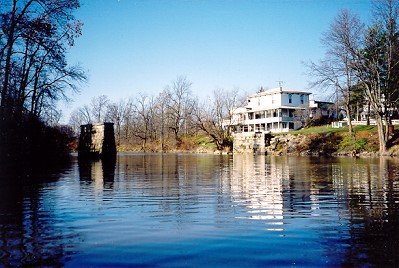 Reading the comment by Jeanette LaRose on her “magical” days on the farm in Wellandport, I was reminded of the times spent canoeing this stretch of the Welland River. Once a thriving shipping community, the little village that now stands on the edge of the river is a picturesque rural town untouched by modern commerce. The surrounding agricultural landscape makes for a delightful visit.
Reading the comment by Jeanette LaRose on her “magical” days on the farm in Wellandport, I was reminded of the times spent canoeing this stretch of the Welland River. Once a thriving shipping community, the little village that now stands on the edge of the river is a picturesque rural town untouched by modern commerce. The surrounding agricultural landscape makes for a delightful visit.
At the time we accessed the river by the Community Centre on Canborough Road where there was a large parking and picnic area. Even at the height of the boating season, there was ample room for safely leaving your vehicle. I imagine this has not changed.
Cows grazing freely on the tree-lined banks and laundry dancing merrily on the clothes lines greeted us as we paddled along the river. Toward town, the remnants of an old bridge remained; one of the few mementos of an earlier time. Passing through the village, we continued into a more isolated area of the river that travels on for miles. Yes it was magical. – B
 Dear Florence- I hope you are enjoying your self this winter. I hope I will be home soon now as the war is over and I like to get back to see you and all the rest. I suppose you like to know what we are doing well not much but still doing a little. Our board is a lot better now. I don’t think I will be home until June or July but I like to be home by the 24 of May so I could spend the day with you. I will close for this time.
Dear Florence- I hope you are enjoying your self this winter. I hope I will be home soon now as the war is over and I like to get back to see you and all the rest. I suppose you like to know what we are doing well not much but still doing a little. Our board is a lot better now. I don’t think I will be home until June or July but I like to be home by the 24 of May so I could spend the day with you. I will close for this time.
 Subscribe..
Subscribe..

 situated on a small plot of land owned by the Town of Fort Erie, but as Americans in gated communities own the surrounding landscape, it was impossible at the time to access this piece of history. We simply had to get closer, so we put the canoe in the water and paddled our way to Utopia. As long as we didn’t venture onto private land and stayed on Lake Erie, we were fine. Mr. Anonymous, bless his heart, could paddle at the speed of light if need be, but without a doubt it was a calm, pleasant journey. I have always thought of my canoe as a miniature yacht, so despite a few furrowed brows from the seamen on larger watercraft, we fit right in.
situated on a small plot of land owned by the Town of Fort Erie, but as Americans in gated communities own the surrounding landscape, it was impossible at the time to access this piece of history. We simply had to get closer, so we put the canoe in the water and paddled our way to Utopia. As long as we didn’t venture onto private land and stayed on Lake Erie, we were fine. Mr. Anonymous, bless his heart, could paddle at the speed of light if need be, but without a doubt it was a calm, pleasant journey. I have always thought of my canoe as a miniature yacht, so despite a few furrowed brows from the seamen on larger watercraft, we fit right in.



 One of my favourite outings is walking the boardwalk on the Friendship Trail through the old Erie Beach Amusement Park. Running parallel to the north shore of Lake Erie, it is an historical treasure. In the late1800s and early 1900s, amusement parks usually located near a river, lake or other large body of water, became a prime source of entertainment for the public. They provided endless hours of diversion. Locales were chosen by the availability of mass transit and limited for the most part to two mediums: steamers and trains. Highways were virtually non-existent and motorized vehicles still a novelty.
One of my favourite outings is walking the boardwalk on the Friendship Trail through the old Erie Beach Amusement Park. Running parallel to the north shore of Lake Erie, it is an historical treasure. In the late1800s and early 1900s, amusement parks usually located near a river, lake or other large body of water, became a prime source of entertainment for the public. They provided endless hours of diversion. Locales were chosen by the availability of mass transit and limited for the most part to two mediums: steamers and trains. Highways were virtually non-existent and motorized vehicles still a novelty.




 Reading
Reading